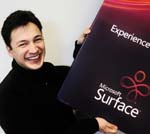Tutorials
Tutorials 8:30am-12:00pm Nov. 13th in room 402.
An introduction to Natural User Interfaces and Microsoft Surface 2
This tutorial material is available. Download (pdf) 3.9Mbyte
Abstract: In this workshop we will talk a little bit about the changes in the way computers are used today. We will discuss the change in command line interfaces (CLI) to graphical user interfaces (GUI) and contrast that to the change from GUI to natural user interfaces (NUI). We’ll define what makes a natural user interface. Then I will introduce you to Microsoft Surface 2 and its PixelSense technology. We will introduce the Microsoft Surface SDK that will enable you to write application not only for Microsoft Surface hardware, but for a variety of Windows 7 touch enabled devices. We will introduce you to the Microsoft Surface Input simulator that will allow you to simulate the tangibles and touch. The principles we will share with you apply to any kind of devices, and you should be able to follow the presentation even if you are not an expert in Microsoft development technologies.
- Speaker: Luis Cabrera-Cordon, Microsoft Surface
 Biography: Luis Cabrera is the Platform Program Manager for Microsoft Surface. He
is passionate about interaction design and creating software development
platforms that are accessible and exciting to use. He oversaw the
release of the Microsoft Surface Toolkit for Windows Touch and the
Microsoft Surface 2 Software Development Kit, and worked closely with
partners to support their efforts in the creation of multi-user
multi-touch applications for the real world. Before helping as a Program
Manager, Luis was a software developer for Microsoft Surface, where he
worked on features such as the Touch Visualizations that were added to
Microsoft Surface v1 sp1. He also worked in the Windows Mobile team for
5 years as a developer, working on the first set of managed APIs that
shipped for Windows Mobile devices. Outside of work, he is a HAM radio
operator, is getting into photography and enjoys spending time with his
family in the Pacific Northwest. He holds a Bachelor’s degree in
Computer Engineering from Brigham Young University and a Master’s degree
in Software Engineering from the University of Washington.
Biography: Luis Cabrera is the Platform Program Manager for Microsoft Surface. He
is passionate about interaction design and creating software development
platforms that are accessible and exciting to use. He oversaw the
release of the Microsoft Surface Toolkit for Windows Touch and the
Microsoft Surface 2 Software Development Kit, and worked closely with
partners to support their efforts in the creation of multi-user
multi-touch applications for the real world. Before helping as a Program
Manager, Luis was a software developer for Microsoft Surface, where he
worked on features such as the Touch Visualizations that were added to
Microsoft Surface v1 sp1. He also worked in the Windows Mobile team for
5 years as a developer, working on the first set of managed APIs that
shipped for Windows Mobile devices. Outside of work, he is a HAM radio
operator, is getting into photography and enjoys spending time with his
family in the Pacific Northwest. He holds a Bachelor’s degree in
Computer Engineering from Brigham Young University and a Master’s degree
in Software Engineering from the University of Washington.
Evaluation methods for collaborative multi-touch support
This tutorial material is available. Download (pdf) 21.8Mbyte
Abstract: This tutorial presents a methodology for the analysis of collaborative work on tabletop or multitouch system. This methodology is appropriate for all kinds of touch interfaces and all kinds of applications. The results of this methodology enable to establish the link between the users and the interface in order to maximize the usability. This is a key component in a design process that conforms to cognitive characteristics and preferences of the end users and prevent rejection of the final application. This tutorial is based on a case study and is particularly relevant for multi-support and decision making application.
- Speaker: Gilles Coppin, Telecom Bretagne
 Biography: Gilles Coppin has a curriculum of Telecommunication engineer and is currently full professor at Telecom Bretagne, graduate school of engineers in France. After 15 years spent in defense industry and airborne systems design, he finally joined research community, and got a PhD at EHESS (Ecole des Hautes Etudes en Sciences Sociales, Paris, France) in 1999. Professor at Telecom Bretagne in 2000, he has been first leading the Artificial Intelligence and Cognitive Sciences department until 2004, then, from 2004 to 2007, a new department, associating human sciences (psycho-ergonomics, sociology) to mathematics and computer science. This multi-disciplinary approach supports and enriches his main research axes and interests, focused on man-machine cooperation, advanced interaction, decision support systems and behavioral analysis. After one year spent at MIT as a visiting professor, he has been leading since 2008 the CID (aka Knowledge, Information, Decision) research group within the Lab-STICC (CNRS UMR 3192). Gilles is involved in many research projects concerning Human Computer Interface and Cognitive Sciences. Amongst these projects, many rely on the use of tabletops and multi-surface systems for cooperative work.
Biography: Gilles Coppin has a curriculum of Telecommunication engineer and is currently full professor at Telecom Bretagne, graduate school of engineers in France. After 15 years spent in defense industry and airborne systems design, he finally joined research community, and got a PhD at EHESS (Ecole des Hautes Etudes en Sciences Sociales, Paris, France) in 1999. Professor at Telecom Bretagne in 2000, he has been first leading the Artificial Intelligence and Cognitive Sciences department until 2004, then, from 2004 to 2007, a new department, associating human sciences (psycho-ergonomics, sociology) to mathematics and computer science. This multi-disciplinary approach supports and enriches his main research axes and interests, focused on man-machine cooperation, advanced interaction, decision support systems and behavioral analysis. After one year spent at MIT as a visiting professor, he has been leading since 2008 the CID (aka Knowledge, Information, Decision) research group within the Lab-STICC (CNRS UMR 3192). Gilles is involved in many research projects concerning Human Computer Interface and Cognitive Sciences. Amongst these projects, many rely on the use of tabletops and multi-surface systems for cooperative work.
Tutorials Chairs
- Edward Tse, SMART Technologies
- Shunsuke Yoshida, NICT
